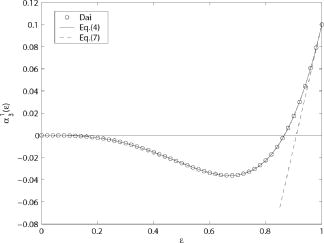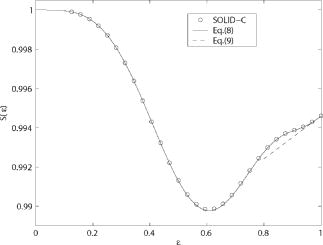|
|
1.IntroductionIt is well known that different lithographic features have different optimal settings of the numerical aperture (NA) and illumination condition.1, 2 Typically the depth of focus or the process latitudes are optimized. To achieve the optimal settings, modern steppers and scanners have a projection lens with a variable numerical aperture, where the NA value can be reduced to about 70% of its maximum value. As a consequence, a smaller fraction of the lens pupil and a corresponding smaller fraction of the phase aberrations is actually involved in the imaging process. In the literature (see Ref. 3 for a survey) the problem of computing the aberration Zernike coefficients of scaled pupils has been discussed at various places. The recent result of Dai3 gives the Zernike coefficients of the scaled pupil in terms of those of the unscaled pupil in analytic form [see Eq. 18]. In this letter we give an alternative expression for Dai’s result. Our main result in Eq. 4 agrees mathematically with Dai’s Eq. 18 but has the advantage that it is very simple and direct in terms of Zernike polynomials. Thus it leads to the simple and explicit results in Eqs. 7, 9 from which the sensitivity of the aberration coefficients and Strehl ratios can be assessed when NA is close to its maximum value. The short and elegant proof of our main result in Eq. 4 is given in Appendix A. 2.Zernike Coefficients of Scaled PupilsWe consider a pupil function on a unit disk with real phase , and we assume that is expanded as a Zernike series according to:where and are integers with being even and , and denotes the Zernike radial polynomial4 of azimuthal order and degree . For simplicity we only consider cosin terms. Scaling to a smaller pupil with relative size means that we have to expand the scaled phase into a Zernike expansion:The problem is how to express the Zernike coefficients of the scaled pupil function in terms of the Zernike coefficients of the unscaled pupil function. In the Appendix A we prove our main result:where the summation is over , and where we use the convention that . We note that (1) the entries do not depend on ; we consider them only for , and (2) since all involved Zernike polynomials, except , equal 1 at .3.Examples and Sensitivity AnalysisFigure 1 shows an example where we scale low-order coma with and . For this special case, Eq. 4 and Dai’s Eq. 18 become andrespectively. Both equations give an identical result, as and .Fig. f1Scaling low-order coma when and . The solid line represents Eq. 4, the dashed line is the tangent line given by Eq. 7, and Eq. 18 is represented by circles.  A consequence of Eq. 4 is that Equation 7 shows a significant sensitivity of when is slightly below its nominal value of 1, especially when high-order aberrations are present. In our example we obtain a relative sensitivity of 11, indicating that the NA value should be specified to accuracy when the required coefficient accuracy is 1%.The Strehl ratio4 is approximated as: in which and the term with is omitted. A consequence of Eq. 7 is thatwhere the two averaging operations are over the whole disk and the rim , respectively. Figure 2 shows the dependence on of the Strehl ratio in the case of a mixture of low- and high-order spherical aberration: and , where the scaled Strehl ratio is calculated by combining Eqs. 8, 4. This result compares well with the numerical calculation obtained from the lithography simulator SOLID-C.5 Intuitively it is expected that the Strehl ratio increases when the NA is decreased. However, in general this is not true. In the special case shown in Fig. 2, the Strehl ratio decreases when the NA is decreased from its maximum value. This result can be seen as follows: as in our example for each value, the phase aberration at the rim of the pupil equals 0. From Eq. 9 it then follows that the slope at is positive.AppendicesAppendix A: Proof of the Main Result, Eq. 4By decoupling per azimuthal order , and normalization and orthogonality4 of , the Zernike coefficients of and the Zernike coefficients of are related by The summation in Eq. 10 is over , andWe shall show thatin particular, it follows that when and that does not depend on , except that in Eq. 10 we only use . For this we use6 when are integers with same parity; in the case of , the right-hand side of Eq. 13 vanishes, which is consistent with the convention that then . We use Eq. 13 in Eq. 11 to rewrite and interchange integrals to getTo the inner integral we apply the resultfrom the Nijboer-Zernike theory,4 and we getNext we use the identity7 and use Eq. 13 to rewrite the resulting two integrals in terms of Zernike polynomials. This gives Eq. 12.Appendix B: Dai’s FormulaWe reproduce Dai’s formula3 for the scaling of Zernike coefficients: with being the maximum value.ReferencesB. J. Lin,
“Signamization of resist images,”
Proc. SPIE, 3051 620
–628
(1997). 0277-786X Google Scholar
A. Engelen,
R. Socha,
E. Hendrickx,
W. Scheepers,
F. Nowak,
M. van Dam,
A. Liebchen, and
D. Faas,
“Optimization on step & scan systems,”
Proc. SPIE, 5377 1323
–1333
(2004). 0277-786X Google Scholar
G. M. Dai.,
“Scaling Zernike expansion coefficients to smaller pupil sizes: a simpler formula,”
J. Opt. Soc. Am. A, 23 539
–543
(2006). https://doi.org/10.1364/JOSAA.23.000539 0740-3232 Google Scholar
M. Born and
E. Wolf, Principles of Optics, 7th ed.Cambridge University Press, Cambridge, MA
(2001). Google Scholar
SOLID-C (release 6.3.0), Google Scholar
R. J. Noll,
“Zernike polynomials and atmospheric turbulence,”
J. Opt. Soc. Am., 66 207
–211
(1976). 0030-3941 Google Scholar
M. Abramowitz and
I. A. Stegun, Handbook of Mathematical Functions, 361 Dover, New York
(1970). Google Scholar
|


